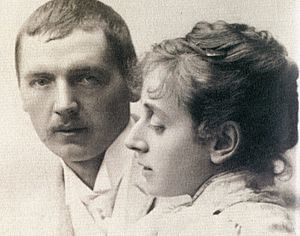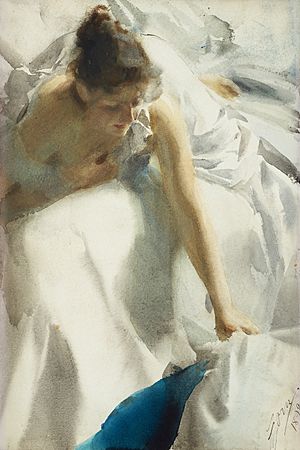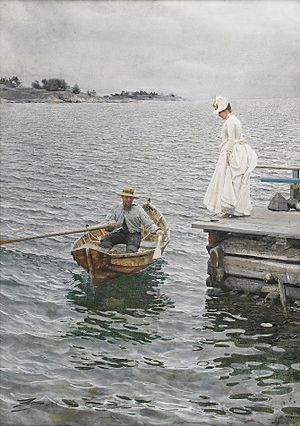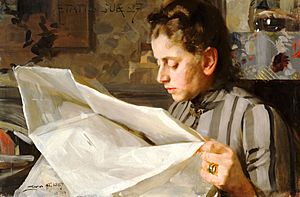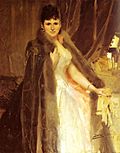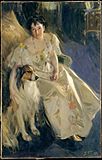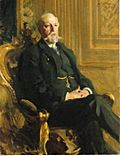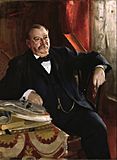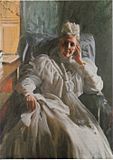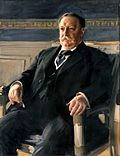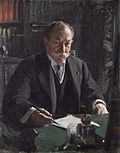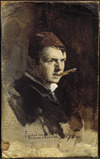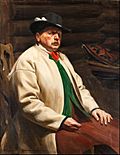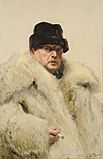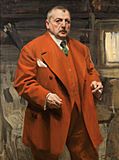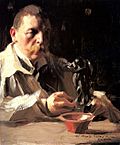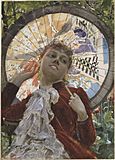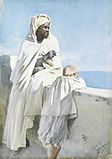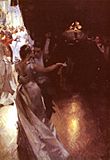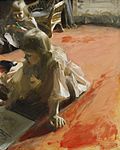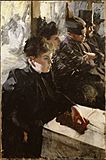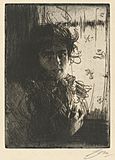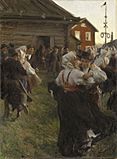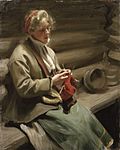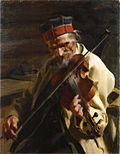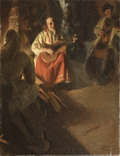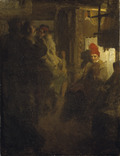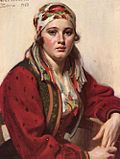Anders Zorn facts for kids
Quick facts for kids
Anders Zorn
|
|
|---|---|
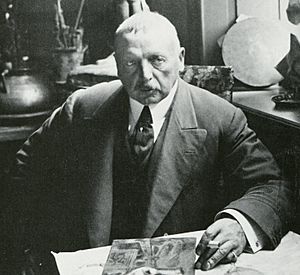
Anders Zorn in 1908
|
|
| Born |
Anders Leonard Zorn
18 February 1860 Mora, Sweden–Norway
|
| Died | 22 August 1920 (aged 60) Stockholm, Sweden
|
| Nationality | Swedish |
| Education | Royal Swedish Academy of Arts, Stockholm |
| Known for | Painting Sculpture Printmaker in etching |
| Spouse(s) | Emma Lamm |
| Signature | |
 |
|
Anders Leonard Zorn (born February 18, 1860 – died August 22, 1920) was a famous Swedish artist. He was known around the world for his paintings, sculptures, and etchings. An etching is a type of printmaking.
Zorn painted portraits of many important people. These included King Oscar II of Sweden. He also painted three American Presidents: Grover Cleveland, William H. Taft, and Theodore Roosevelt. Near the end of his life, Zorn helped create the Swedish Bellman Prize in 1920. This prize is given to talented writers.
Contents
About Anders Zorn
Anders Zorn grew up on his grandparents' farm in a small village called Yvraden. This village is near Mora in Dalarna, Sweden. He went to school in Mora Strand until he was twelve. Then, in 1872, he moved to a bigger school in Enköping.
From 1875 to 1880, Zorn studied at the Royal Swedish Academy of Arts in Stockholm. His teachers were very impressed by his amazing talent. Soon, important people in Stockholm started asking him to paint for them. In 1881, Zorn met Emma Lamm. She came from a rich family and loved art. After being engaged for a long time, they got married in 1885.
Zorn traveled a lot to places like London, Paris, Spain, and the United States. He became very successful all over the world. Many people thought he was one of the best painters of his time. He was especially famous for his portraits. He could capture the unique personality of the people he painted. As mentioned, he painted three American Presidents: Grover Cleveland, William H. Taft, and Theodore Roosevelt.
Awards and Recognition
When Anders Zorn was 29 years old, he received a special honor. He was made a Chevalier de la Légion d'honneur. This happened at the Paris World Fair in 1889. It was a big award from France.
- Famous Portrait Paintings
-
Mrs. Potter Palmer, 1893
-
King Oscar II of Sweden, 1898
-
Frances Cleveland, wife of President Grover Cleveland, 1899
-
President Grover Cleveland, 1899
-
William Howard Taft, 27th President of the United States, 1911
Zorn's Art Collection
Anders Zorn earned a lot of money from his art. This allowed him to buy many artworks for his own collection. He bought art not only in Sweden but also during his travels abroad. Anders and Emma Zorn decided to give all their art and belongings to the Swedish government. This was written in their will.
Some of Zorn's most important paintings are at the National Museum of Fine Arts in Stockholm. One famous painting there is Midsummer Dance (1897). It shows people dancing during a summer evening celebration. Other museums with Zorn's works include the Musée d'Orsay in Paris and the Metropolitan Museum of Art in New York.
The Zorn Collections are a group of four museums in Mora and Garberg, Sweden. They are all about Anders Zorn's life and art. The main museum, Zornmuseet, was designed by Ragnar Östberg. It opened in 1939. Here you can see many of Zorn's own works. You can also see art he collected by other famous artists.
The Bellman Prize is an award for "an outstanding Swedish poet." The Swedish Academy gives out this prize every year. Anders Zorn and his wife Emma started this prize in 1920.
Zorngården: Zorn's Home
In 1886, Anders and Emma Zorn bought some land near the church in Mora. They moved a small cottage from his grandfather's farm to this land. After living abroad for several years, Anders and Emma decided to return to Sweden. They began to make their cottage much larger. Their home, called Zorngården, was finished in 1910.
Zorngården looks much the same today as it did when Emma Zorn passed away in 1942. It is a great example of an artist's home from the early 1900s. The house mixes English and Swedish building styles. It shows the freedom in architecture around that time.
The main part of Zorngården is Zorn's home and a museum of his art. But there are two other museums that are also part of the Zorn Collections. Gammelgården is in southern Mora. It has about 40 old wooden houses that Zorn bought. He wanted to make sure the old way of building these houses was not forgotten. Gopsmor is a quiet place in Älvdalen where Zorn went to relax. It is only open to visitors in July.
- Self Portraits
Zorn's Paintings
Zorn's early artworks were often bright and glowing watercolors. But by 1887, he started using oil paints instead. Zorn created a huge number of artworks throughout his life. He became very famous around the world for his portraits. He painted American Presidents, kings, queens, and many other important people. Zorn also painted his family, friends, and himself.
He enjoyed painting women from his home region of Dalarna. These women were sometimes called Zornkulla or dalkulla. This term means an unmarried woman or girl from Dalarna in the local dialect.
- Other Paintings
-
Anders Zorn - Skärgårdsblomster.jpg
Skärgårdsblomster (Archipelago flower), 1916
Zorn's paintings look free and full of energy, almost like quick sketches. He used warm and cool colors to show light and shadow. He understood how colors contrast and how light reflects off surfaces. Zorn was very skilled with his brush. This allowed the shapes and textures in his paintings to truly capture and show light.
Zorn's Color Palette
Anders Zorn was known for using a very simple set of colors. He typically used only four main colors: Lead White, Yellow Ochre, Vermilion, and Ivory Black. Even with so few colors, he could create a huge range of different shades and tones. This was very important for his portrait paintings.
This limited palette could also be used for still life and landscape paintings. One cool thing is that he could make an olive greenish color. He did this by mixing Ivory Black with Yellow Ochre, because Ivory Black naturally has a bluish tint.
Other Important Works
- Martha Dana (later Mrs. William Mercer) (1899) Museum of Fine Arts, Boston
- George Peabody Gardner (1899) Museum of Fine Arts, Boston
- A Portrait of the Daughters of Ramón Subercaseaux (1892), Private collection
- Traveling companion (Mr. Charles Deering) (1904) Museum of Fine Arts, Boston
Works Gallery
-
An Irish Girl, 1894, National Gallery of Art
-
Hins Anders, a fiddler, 1904 (Thiel Gallery)
See Also
 In Spanish: Anders Zorn para niños
In Spanish: Anders Zorn para niños
- Bruno Liljefors
- Zorn Collections
Other Sources
- Birnbaum, Britta (1985). Paintings at Nationalmuseum. (Stockholm: Nationalmuseum) ISBN: 91-7100-273-1
- Lidbeck, Sven (2007). Anders Zorn Etchings – Catalogue Raisonné 2007. (Stockholm: Zorn Gallery) ISBN: 978-91-631-8962-3
- "Anders Zorn in the Gilded Age", PBS biography (Colorado Public Television), one hour, 2013.
- Oliver Tostmann, ed., Anders Zorn: A European Artist ... America (Boston: The Isabella Stewart Gardner Museum, 2013)
- ArtGraphica biography


